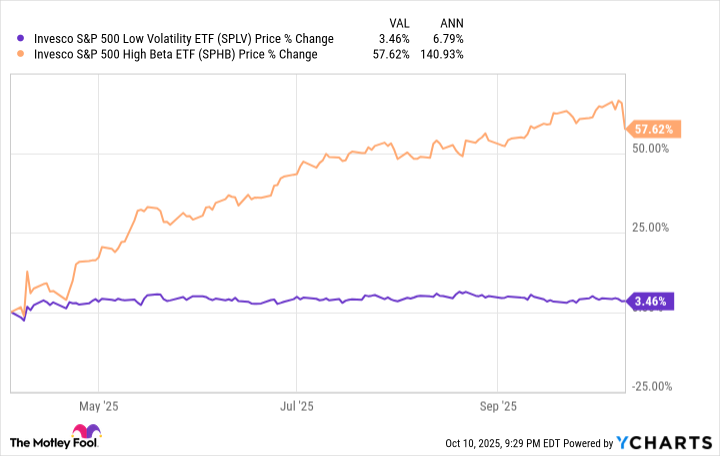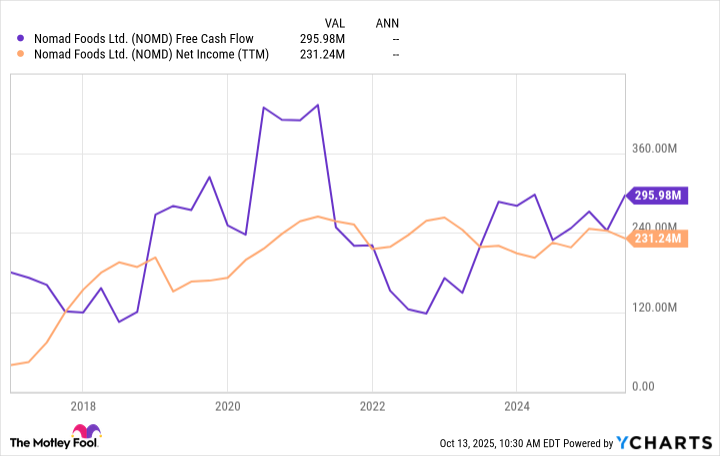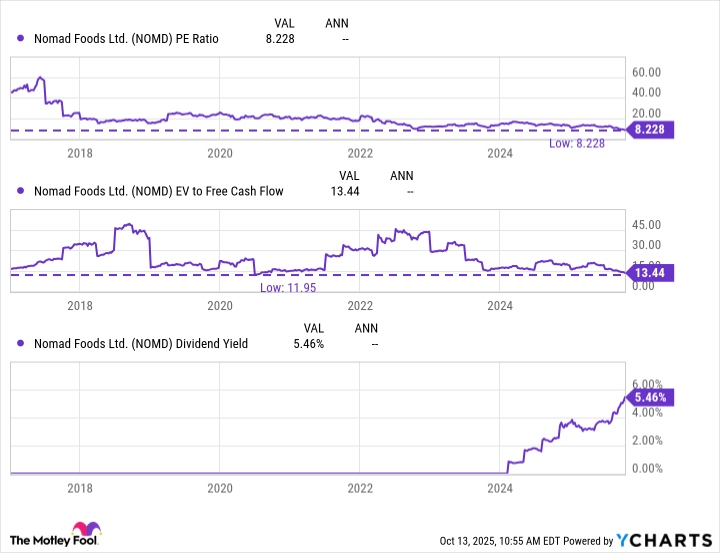The market may continue to trade near all-time highs, but growth stocks have done most of the heavy lifting.
This delineation can clearly be seen in the chart below, showing the performance of two index-tracking exchange-traded funds (ETFs). As you can see, there is quite a difference between the last six months' performance from high beta (growth-ish) and low volatility (value-ish) stocks in the S&P 500.
Data by YCharts.
Said another way, a lot of growth stocks' valuations have become stretched, while many Steady Eddie businesses remain reasonably valued.
Today, I will look at an ultra-high-yield dividend stock that has been left behind by the bull market and explain why it may be a once-in-a-decade opportunity.
Nomad Foods: Europe's leading frozen food provider
Anchored by brands like BirdsEye, Iglo, Aunt Bessie's, and Goodfellas, Nomad Foods (NOMD +0.41%) is the dominant force in Europe's frozen food industry.
Nomad holds a 47% market share among its top 25 products, primarily selling frozen food in the following categories:
- Fish: Consists of fish fingers, breaded fish, and natural fish. This is the largest category for Nomad, equalling 33% of sales.
- Vegetables: Ready-to-cook frozen vegetables account for 25% of revenue.
- Meals: Products range from noodles, pasta, and lasagna to pancakes and other ready-made meals.
- Poultry: Includes chicken nuggets, burgers, and grilled meat.
- Ice cream and others: Consists of numerous ice cream options as well as pizza, soups, baked goods, and meat substitutes.

Image source: Getty Images.
Leading these categories across most of Europe, Nomad Foods' various brands are ranked No. 1 in brand awareness and preference among consumers in 12 of 15 markets.
With two-thirds of its portfolio consisting of protein or vegetable offerings, Nomad is well-positioned to thrive amid the global shift toward healthier food options.
Steady cash flows offset a hefty debt load
Thanks to the repeat-purchase nature of its products, Nomad is a very stable operator, generating consistent cash flows and profitability over time.
Data by YCharts.
While revenue growth has stalled recently due to consumer uncertainty, management expects free cash flow (FCF) to grow by 15% annually over the next three years as capital expenditures drop and efficiency programs take hold.
This growing FCF is important for Nomad as the company is home to $2.2 billion in debt, versus a market capitalization of $1.8 billion.
Typically, it is a bad sign when a company's debt exceeds its market cap. However, in Nomad's case, a lot of this is due to its discounted share price -- and its consistent FCF and profitability show it can easily handle its debt payments.
A once-in-a-decade valuation and an ultra-high-yield dividend
The main reason that Nomad's market cap is lower than its net debt balance stems from the fact that its share price is down 41% from its one-year high.

NYSE: NOMD
Key Data Points
While there is nothing fundamentally wrong with Nomad's business, this sell-off matches what has happened to a lot of low-volatility stocks in the market, as I pointed out earlier.
Following this decline, the company currently trades at a decade-long low valuation, and its dividend yield is at an all-time high of 5.5%.
Data by YCharts.
What makes this ultra-high-yield dividend even more interesting is that it only uses 43% of the company's net income, or 35% of its FCF. These figures show that the 13% dividend increase investors saw to start the year isn't likely to be Nomad's last, as its dividend payments are very well funded.
In addition to this hefty dividend yield, management has lowered the company's share count by a staggering 6% annually over the last three years. This combination of ultra-high-yield dividend payments and hefty share repurchases makes Nomad a very shareholder-friendly investment.
Ultimately, Nomad Foods won't ever be mistaken for a growth stock. However, its industry leadership, stable operations, consistent cash flow, and generous shareholder returns make it a compelling investment opportunity while it trades at a once-in-a-decade low valuation.




